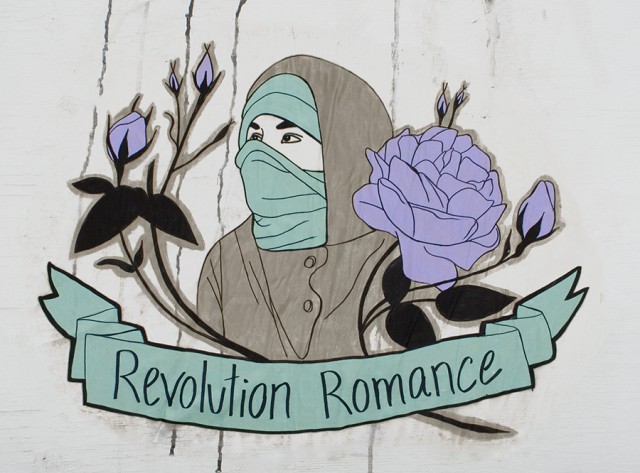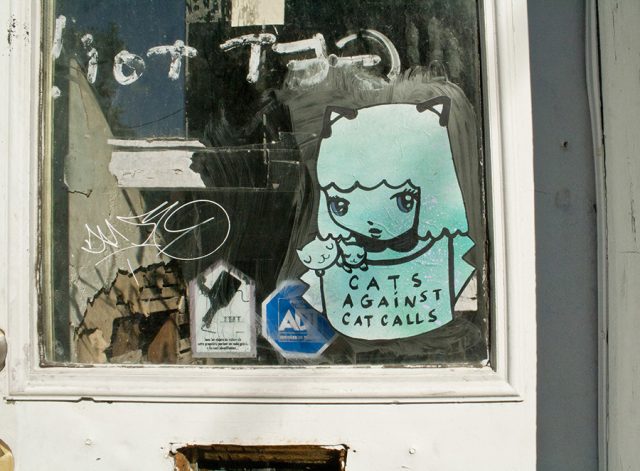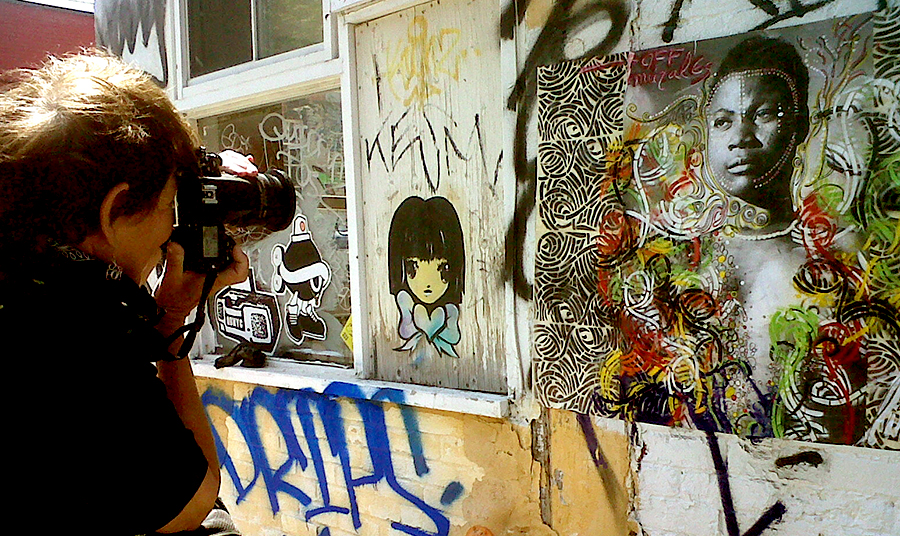The artists in the OFFmuralES collective are referred to in this article by their chosen street art names: Harpy, Lilycuciole, Stela, and Zola.
Enter the square white room, a newly-sponsored gallery space. The cube presents the art, which is supposed to speak for itself – because art can speak to you, really – and the white frames the work, contextualizes it. We are told that the space is there, but not. It negates itself so you can focus on the art. If you feel isolated, have no fear because after the show, you can leave the space, forget the socio-historical context and politics that made the work available to you, and go shoot the breeze about the aesthetics over a cup of third wave coffee and a flaxseed vegan muffin, if that’s your thing.
Street art and graffiti are cool and trendy now; they’re popular. In the 1990s, the rise of graffiti into fashion was exponential. You could wear the elusive culture on your back, an aesthetic without the context of the street and the politics, because politics are only cool if you’re not too intense about it. And now, another wave of commodification of street art and graffiti culture is hitting Montreal.
At what point did we create these structures that institutionalize certain forms of art and criminalize others? At what point did we decide to create a cultural currency for art, including street art and graffiti, determined by the market rate? The demographics of artist visibility are still laden with problems that art historians have picked at in the past. Street art and graffiti have reckoned with demystification over the last few decades, with all varieties of literature, from academic writing to blog posts about the artists and where they are coming from.
Nonetheless, the consumer report on street art – and the focus of this piece is street art, not graffiti, usually defined by medium – is lacking in perspective. Scouring the academic literature, the journalistic articles, the blog posts, you have to ask: where are the women? The people of colour? Where are the people who identify as queer, as trans*? They exist. The feminist, anti-racist, anti-colonial, and anti-corporate street art collective OFFmuralES brings this question to the city of Montreal by creating a visual culture that is available to those who can see it, reimaging Montreal’s cityscape.

“With the idea of collectively joining our critiques of the festival,” reads the first page of OFFmuralES, the collective’s self-titled zine, “many of us met in order to organize our own event, at the margin of MURAL. We wanted to present our work, excluded from the distribution, as an alternative vision to the one presented by the festival.”
MURAL was sponsored by the Osheaga Festival and Desjardins Caisse Portugaise, among others, and employed the rhetoric of community. “Our meeting gave us the opportunity to create new solidarity friendships and a network of support and creative inspiration,” the zine’s text continues, combatting the street art culture that is bred by the monetary-based street art and graffiti festival.
“Street art becomes ‘co-opted,’ the [festival participants] are not about community building and local politics anymore, but about fame and money,” said Zola, an artist who works with OFFmuralES. Lilycuciole, another artist in the collective, said that corporate-driven art “destroys the relationship between the actors in this community. It excludes and breaks the integration of new players who have something to say or share.”

“They can reclaim whatever they want. They can claim our ideas as theirs. They can say, ‘We’re going to have that many women, that many persons of colour.’ They can say that, but as soon as they’re within that system, that capitalist system, these elitist ideas of who’s a great artist or not, then the space will never be safe for people who are marginalized within this system. I’ll never feel safe there,” said Stela, a member of OFFmuralES.
***
“For street art to be effective, you need to think about so many layers. The place you’re in, what [you’re] expecting from it,” said Stela, who has been doing graffiti for over eight years. “The first thing I often decry about Station 16 and MURAL would be the lack of diversity in the artists they feature,” Zola said. “But in fact the problems are much deeper than that. It is the vision of what street art is and how it can be used that marks a radical change with them.”
On its website, Station 16 describes itself as “[an] urban art gallery and creative silkscreen print shop.” It represents different street and graffiti artists through a private gallery system. Zola says the dynamics of MURAL – that is, the question of community, lack of diverse participants, and a sliding scale of payment for artists dependent on the organizers’ choice – existed before its inauguration, but were only amplified during that time.
“The people who gravitate around the ‘community’ are almost exclusively males. Some of them are represented by Station 16, [which] represents very close to no females or trans* [people] at all […] and these people have career interests,” said Zola on the corporate construct of community. “Then there are the others who all have their opinion on Station 16 and most of the time will not like the gallery’s ways and discourse,” said Zola, citing OFFmuralES as sitting on that “other side.”
The domain of the street, through corporate-driven festivals, is divided up among those artists that corporations and organizations judge fit to claim it. The institutional memory of street art and graffiti, through its literature, operates much in the same way. There is no lack of people out writing on the walls who do not conform to the heteronormative male worldview out writing on walls, only a lack of representation in the public imagination and literature.
“As the street is perceived as the domain of man and the site of his adventure, it is therefore not surprising that, in popular imagination, the street artist is first and foremost a solitary male marking his territory,” wrote Harpy in the OFFmuralES zine co-published with the Howl! Arts Collective.
Harpy; from the French word harpie. Nom féminin en français. Monstre fabuleux, femme très méchante.
Jessica Pabón, who runs Bustoleum, “a blog dedicated to graffiti writing women,” wrote to me, “I think the only way to approach street art and grrlz involvement in it is to assume that they have to navigate the same social scene, and follow the same kinds of ‘rules and regulations’ in terms of subcultural dynamics, but that they also have to navigate the material effects of their gender as marginalized minorities in an overwhelmingly sexist male-dominated subculture.” Pabón’s dissertation, which she wrote at New York University’s Tisch School of the Arts, is entitled “The ‘Art of Getting Ovaries’: Female Graffiti Artists and the Politics of Presence in Hip Hop’s Graffiti Subculture.”
“It is less about essentializing them as ‘all grrlz do this’ and more about taking account of difference within the subculture,” wrote Pabón.
“As a woman you become hypervisible in the city at night, so when we paired together we were already more threatening than when we were alone,” said Stela on the OFFmuralES collective. She believes in empowering other artists by offering “to support other people’s projects in a way that can help them. For example, some of the people in the group are doing textile work, which takes a long time to install, so this is something I can do, to go and help them put it up.”
Zola began creating street art by yarnbombing, the manifestations of knit attacks you see wrapping various structures around the city. It was in the early spring of 2011. She said it was her way of participating in a movement. “It was political, it was artistic, and it was heart warming.” According to Zola, the inherent politics of yarnbombing – aside from the illegality of fixing textile works in the public – is as feminist as it was when Miriam Schapiro first used textiles in the world of fine art in the 1980s.
Displacing the ‘domestic’ to the public realm as a form of cultural production removes a bit of that calibrated secrecy around identity in street art. Identifying as a woman, as a person of colour, as queer, as trans* in your art, and making that visible on the street becomes a political act. “When I began to see my experience in that scene as a sexist experience, I guess I cannot see anything that I do, street art-wise, as not political, because it is. Because I was not supposed to still be there,” said Stela.
***
There is a black and white portrait of a woman of East Asian background wheat-pasted on St. Laurent. The woman is looking upward in the shot, palms clasped together, surrounded by painted flora. On the wall, she is striking. I realized that this was one of the few instances that I saw a face that I could identify with on the streets of this city, leading me to scour the walls looking for more. I spoke to Lilycuciole, the artist behind these works. “An anti-colonial art is an art that does not establish a hierarchy between the creators,” she wrote. “An art that integrates all actors independently of the colour [of their] skin, origins, social class, political affiliation, religious beliefs.” Her project is called “Revelation,” which comes from the “misunderstandings, ignorance, and racism among people both in Montreal and Paris,” according to an interview with Powder Magazine.
Montreal is lacking a public forum for dialogue about street art, a dialogue that OFFmuralES created for their collective. The walls strewn with writing are standing on unceded land, Mohawk territory. When street artists reclaim space, do they think about whose land they walk on? When an artist creates a work, do they pick a corporation’s window as their canvas, or a local business that might not be financially able to remove the paint? Who gets to paint there? Who are they?

“As I started to identify as a feminist and as a rape survivor, and so on, these are things that if I do that, these experiences are with me when I do that, when I reclaim space,” said Stela. Since coming out as a rape survivor in an interview over a year ago, Stela said that she has been approached by girls saying graffiti artists had raped them, adding, “It’s super hard to participate in an interview like this because [what I have to say is] often not what people want to say in their paper.”
Enter the street, white skies, newly-sponsored gallery space. The street presents the art, which is supposed to speak for itself – because art can speak to you, really – and the brick walls and concrete jungle frame the work. The street contextualizes it, marks gentrification, and cannot negate itself.
If you feel isolated, have no fear, because you can find faces or messages in the writing on the walls of Montreal you may identify with, like I did. We don’t leave the public space, and we can’t forget the socio-historical context and politics that make street art available to us. You can shoot the breeze about the aesthetics of street art over a cup of third wave coffee and a flaxseed vegan muffin, if that’s your thing, but the consumer report on street art and graffiti is continuously being written, and feminist, anti-racist, anti-colonial, and anti-corporate artists are still taking to the streets. The work is framed for you. Do you miss the white walls yet?

